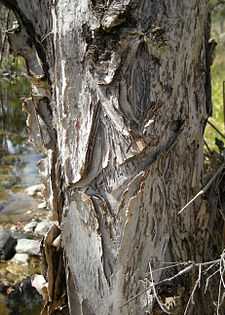Melaleuca linariifolia
| Snow-in-Summer | |
|---|---|
 | |
| Scientific classification | |
| Kingdom: | Plantae |
| (unranked): | Angiosperms |
| (unranked): | Eudicots |
| (unranked): | Rosids |
| Order: | Myrtales |
| Family: | Myrtaceae |
| Genus: | Melaleuca |
| Species: | M. linariifolia |
| Binomial name | |
| Melaleuca linariifolia Sm. | |
Melaleuca linariifolia, popularly known as Snow-in-Summer, is a plant native to eastern Australia. Other names include Narrow-leaved Paperbark, Flax-leaved Paperbark and the Gadigal Budjur.[1][2] The taxonomy of Melaleuca linariifolia has recently undergone revision and another species, Melaleuca trichostachya has been split out.
Description
Melaleuca linariifolia is found in heath and dry sclerophyll forest habitats, usually growing near watercourses or swamps.[2]
The tree grows to 5–10 metres (16–33 ft) high and 3–6 metres (9.8–19.7 ft) wide. It has distinctive and attractive creamy white papery bark. The tree bears perfumed, white flowers in early summer. The flowering can be profuse, covering the tree in white and giving rise to its common name.

Cultivation
Melaleuca linariifolia is cultivated as an ornamental tree for parks and gardens. It is popular as a nature strip tree in Melbourne. It is also used as a screen or windbreak. It tolerates both dry and boggy conditions and is frost hardy. The tree attracts a wide variety of insects and birds. It commonly has a number of structural faults that can result in limb failure when tree is mature or around 30 plus years old.

References
| Wikimedia Commons has media related to Melaleuca linariifolia. |
- ↑ Association of Societies for Growing Australian Plants (ASGAP): Melaleuca linariifolia
- ↑ 2.0 2.1 New South Wales Flora Online: Melaleuca linariifolia by G. Wilson, Royal Botanic Gardens & Domain Trust, Sydney, Australia.